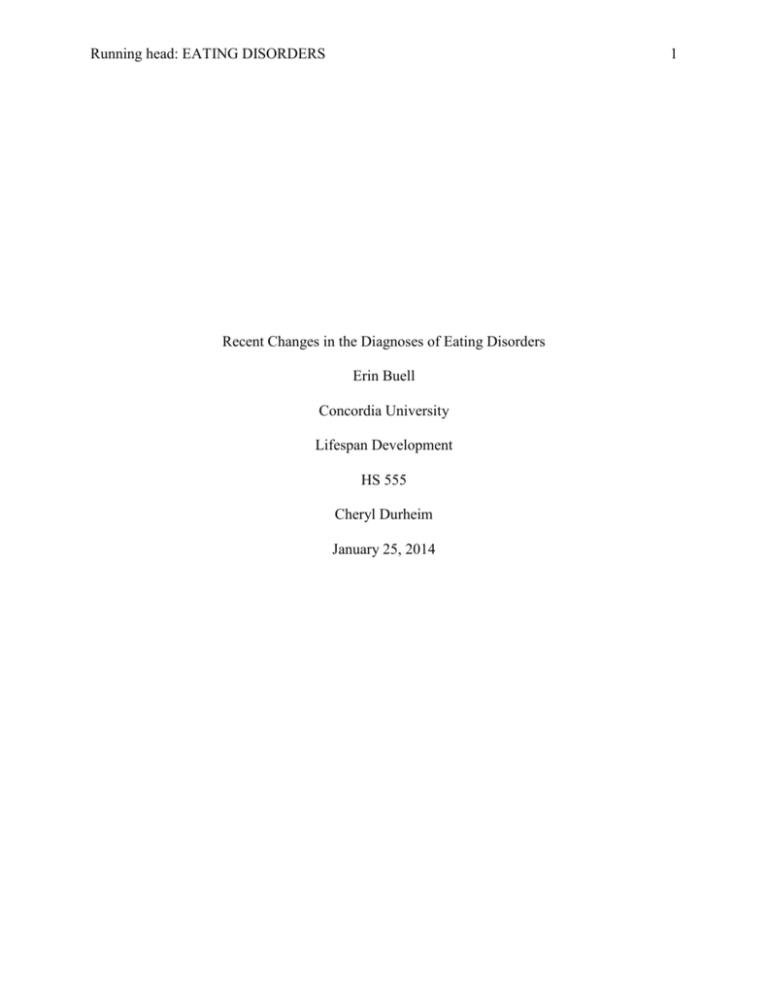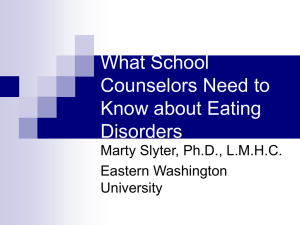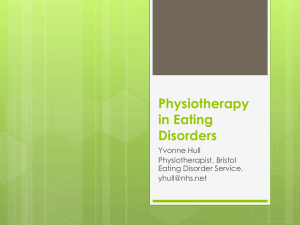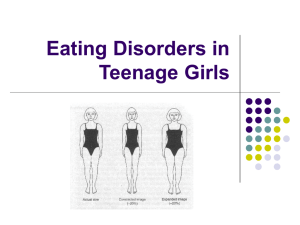Week 3 Eating Disorders. Assignment
advertisement

Running head: EATING DISORDERS 1 Recent Changes in the Diagnoses of Eating Disorders Erin Buell Concordia University Lifespan Development HS 555 Cheryl Durheim January 25, 2014 EATING DISORDERS 2 Recent Changes in the Diagnoses of Eating Disorders Anorexia nervosa (AN) and bulimia nervosa (BN) were recognized in the Diagnostic and Statistical Manual (DSM) IV. The chapter of DSM IV titled Disorders Usually First Diagnosed in Infancy, Childhood or Adolescence, was the location of these diagnostic entities (American Psychiatric Publishing, 2013). However, the DSM V, released in May 2013, does not include this chapter. Instead, this new manual recognizes eating disorders as a category of diagnoses that is identified throughout the lifespan. Furthermore, other eating disorder conditions besides AN and BN, such as pica (compulsive cravings to eat non –food items), rumination and avoidance or restrictive food intake disorder, and binge eating disorder are included in the DSM V that were not identified in previous versions (American Psychiatric Publishing, 2013). Eating disorders not otherwise specified, or EDNOS, has been a category of default for many eating disorders, and is now getting attention in order to determine if a significant number of these cases are actually binge eating disorders (American Psychiatric Association, 2013). Prevention, intervention, and treatment are key concepts in literature addressing these disorders. Inclusion of a broader scope within the DSM-V draws specific diagnostic definition for medical and psychology professionals and may enable clinical professionals to make better diagnoses and prescribe treatment in conventional and professionally recognized medical methods. Anorexia nervosa is characterized by body weight 15% below specified ideal healthy weight, distorted body image, dieting that leads to extreme weight loss, and pathological fear of gaining weight or being fat (Beerbower & Contner, n.d). In the DSM IV, amenorrhea was included as a criterion for the diagnosis of AN (American Psychiatric Publishing, 2013). In the current manual, amenorrhea is being eliminated. Amenorrhea can only be a possible factor in EATING DISORDERS 3 women and adolescent girls, which excludes the possibility of this diagnosis for males, young girls, post-menopause women, pregnant females, or women who do not menstruate for other reasons (American Psychiatric Association, 2013). Anorexia nervosa has the highest mortality rate of eating disorders. Research points to predictors of increased mortality linked to chronicity and severity of illness. Research is primarily based on information obtained upon physician visits and hospitalization of the affected individual (Haus, et al., 2010). Girls aged 15 – 19 are recognized as the highest risk group for anorexia nervosa, yet it occurs throughout the life span and crosses gender parameters. Binge eating disorders are reported to be the most common eating disorders among men and older individuals, and can be associated with unhealthy weight gain (Smink, VanHoeken, & Hoek, 2012). Traditional diagnoses and treatment include psychiatric and psychological care, nutrition counseling, and hospitalization. In addition, some current research and literature is addressing whether internet-based programs have merit in improving outcomes for individuals affected with eating disorders. Evidence has been collected regarding the efficacy of internet based interventions for conditions such as depression, anxiety, and the prevention of eating disorders. While internet based interventions exist for eating disorders, the quest for determining outcome of such programs is under current investigation (Dolemeyer, Tietjen, Kersting, & Wagner, 2013). Advantages of internet based programs appear to include that they provide easy access, especially for the adult population, allow user control and flexibility, and support anonymity. Risks involve the absence of direct clinical care. Evidence shows that anorexia and other eating disorders have existed throughout history (Dean, 2011), but the primary focus has been on anorexia and bulimia in adolescent girls and EATING DISORDERS 4 young women (American Psychiatric Publishing, 2013). Attention is growing on other demographics such as men and boys, children, and middle aged individuals. Collecting exact data is difficult as many individuals with eating disorders do not seek clinical help and are not included in statistics. However, according to the National Eating Disorder Association, an estimated 20 million women and 10 million men are reported to have eating disorders, (NEDA, n.d.). New vocabulary of terms for non-clinically recognized forms of eating disorders has surfaced in recent years, including orthorexia (obsession with eating healthy food to the extent of severe food restriction.), pregorexia (eating disorder during pregnancy), drunkorexia (food restrictions in favor of alcohol consumption), and diabulimia (individuals with diabetes eliminating or reducing insulin specifically for the purpose of being thin) (Beerbower & Contner, n.d). These terms are not readily found in peer reviewed literature, but are currently more frequently discussed in popular journals. As the DSM V integrates into the clinical professions, research and metrics will be delineated based on new clinical criteria for the prevention, recognition, intervention, diagnoses, and treatment of eating disorders. The catch-all diagnoses of eating disorder not otherwise specified (ENOS), other specified feeding and eating disorder (OSFED), and unspecified feeding and eating disorder (UFED) do not support clinicians efforts to identify a specific diagnoses based on symptoms and behaviors (American Psychiatric Association, 2013). The modifications within the DSM V will help both patients and medical professionals create and implement treatment plans through more accurate diagnoses (American Psychiatric Association, 2013). EATING DISORDERS 5 References American Psychiatric Publishing.(2013). Highlights of changes from DSM-IV-TR to DSM-5. Retrieved from http://www.dsm5.org/Documents/changes%20from%20dsm-ivtr%20to%20dsm-5.pdf American Psychiatric Association. (2013). Feeding and Eating Disorders. Retrieved from http://www.dsm5.org/Documents/Eating%20Disorders%20Fact%20Sheet.pdf Beerbower, K., & Contner, E. (n.d). Emerging trends in the field of eating disorders. . Retrieved from http://www.cigna.com/assets/docs/behavioral-health-series/eastingdisorder/2012/emergingTrends.pdf Dean, E. (2011, December 11). A history of eating disorders. Psychology Today. Retrieved from https://www.psychologytoday.com/blog/evolutionary-psychiatry/201112/history-eatingdisorders Dolemeyer, R., Tietjen, A., Kersting, A., & Wagner, B. (2013). Internet-based interventions for eating disorders in adults: a system review. BMD Psychiatry, (), 1-16. Retrieved from http://web.ebscohost.com.vproxy.cune.edu/ehost/pdfviewer/pdfviewer?vid=4&sid=97389 488-002c-4a9b-996c-803f6b162478%40sessionmgr4002&hid=4207 Haus, C., Caille, A., Godart, N., Faulon, C., Pham-Scottez, A., Divac, S., ... Falissard, B. (2010). Factors predictive of ten-year mortality in severe anorexia nervosa patients. Acta Psychiatrica Scandinavica, 123(1), 62-70. http://dx.doi.org/ 10.1111/j.16000447.2010.01627.x NEDA. (n.d.). Get the facts on eating disorders; what are eating disorders? Retrieved from http://www.nationaleatingdisorders.org/get-facts-eating-disorders EATING DISORDERS 6 Smink, F. R., VanHoeken, D., & Hoek, H. W. (2012, May 27). Epidemiology of eating disorders; incidence, prevalence and mortality rates. Current Psychiatry Reports, 14, 406414. http://dx.doi.org/10.1007/s11920-012-0282-y









